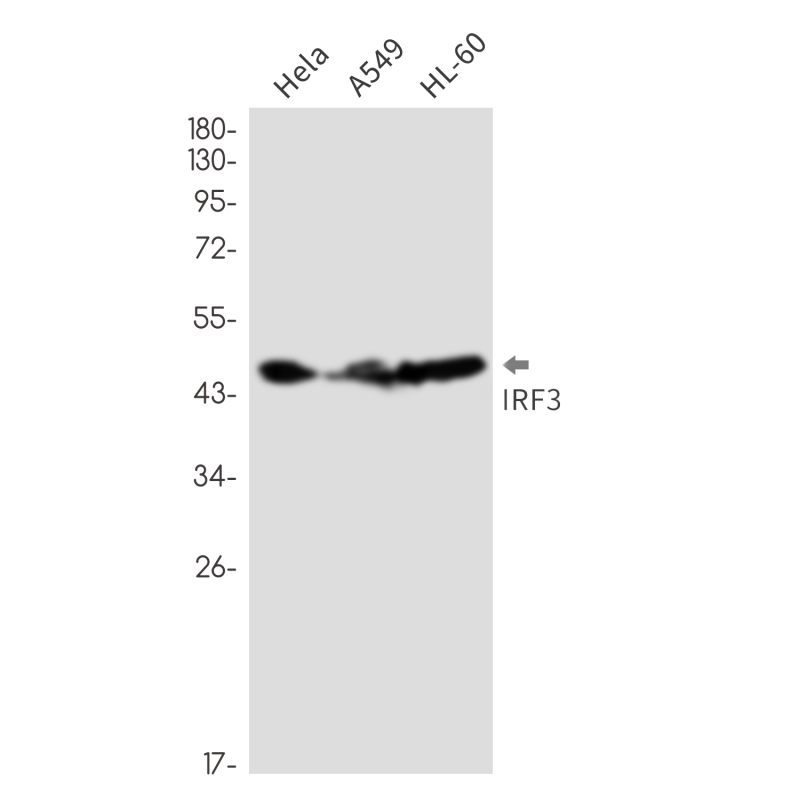

| WB | 1/500-1/1000 | Human,Mouse,Rat |
| IF | 1/20 | Human,Mouse,Rat |
| IHC | 1/50-1/100 | Human,Mouse,Rat |
| ICC | 技术咨询 | Human,Mouse,Rat |
| FCM | 咨询技术 | Human,Mouse,Rat |
| Elisa | 咨询技术 | Human,Mouse,Rat |
| Aliases | IRF3; Interferon regulatory factor 3; IRF-3 |
| Entrez GeneID | 3661 |
| WB Predicted band size | Calculated MW: 47 kDa; Observed MW: 47 kDa |
| Host/Isotype | Rabbit IgG |
| Antibody Type | Primary antibody |
| Storage | Store at 4°C short term. Aliquot and store at -20°C long term. Avoid freeze/thaw cycles. |
| Species Reactivity | Human |
| Immunogen | A synthetic peptide of human IRF3 |
| Formulation | Purified antibody in TBS with 0.05% sodium azide,0.05%BSA and 50% glycerol. |
+ +
以下是关于IRF3抗体的3篇参考文献示例(内容为模拟,仅供参考):
1. **文献名称**:*IRF3 mediates a TLR3/TLR4-specific antiviral gene program*
**作者**:Honda K, et al.
**摘要**:该研究通过Western blot和免疫共沉淀技术,利用IRF3抗体揭示了TLR3/4信号通路中IRF3的磷酸化及二聚化机制,证实其在诱导I型干扰素中的关键作用。
2. **文献名称**:*Viral infection switches TLR3-positive human neurons to be strong producers of IFN-β*
**作者**:Sato M, et al.
**摘要**:研究使用IRF3特异性抗体进行免疫荧光染色,发现病毒感染通过激活神经元内IRF3的核转位,促进IFN-β的高效表达,揭示了神经细胞的抗病毒应答机制。
3. **文献名称**:*Regulation of IRF3 activation in human macrophages by dsRNA-dependent protein kinase*
**作者**:Takahashi K, et al.
**摘要**:通过IRF3抗体检测病毒感染后巨噬细胞中IRF3的磷酸化状态,发现PKR蛋白激酶通过调控IRF3活性影响下游干扰素信号通路,为抗病毒治疗提供新靶点。
Interferon Regulatory Factor 3 (IRF3) is a transcription factor central to innate immune responses, particularly in antiviral signaling. Structurally, it contains a conserved N-terminal DNA-binding domain and a C-terminal regulatory domain. In resting cells, IRF3 remains inactive in the cytoplasm. Upon detection of viral pathogens or double-stranded RNA by pattern recognition receptors (e.g., TLR3. RIG-I), signaling cascades activate kinases like TBK1 or IKKε, which phosphorylate IRF3 at specific serine/threonine residues. This triggers IRF3 dimerization, nuclear translocation, and binding to interferon-stimulated response elements (ISREs) in DNA, driving expression of type I interferons (IFN-α/β) and pro-inflammatory cytokines.
IRF3 antibodies are essential tools for studying this pathway. They enable detection of IRF3 expression, phosphorylation status, and subcellular localization through techniques like Western blotting, immunofluorescence, and flow cytometry. Phospho-specific antibodies distinguish activated IRF3 from its inactive form, providing insights into signaling dynamics. Researchers use these antibodies to investigate viral immune evasion mechanisms, autoimmune disorders linked to IRF3 dysregulation, and cancer immunotherapy strategies targeting innate immunity. Commercial IRF3 antibodies are typically validated for specificity using knockout cell lines or siRNA knockdown controls. As IRF3 activation is tightly regulated by post-translational modifications, antibody selection must align with experimental goals—whether studying total protein levels, activation states, or interaction partners.
×